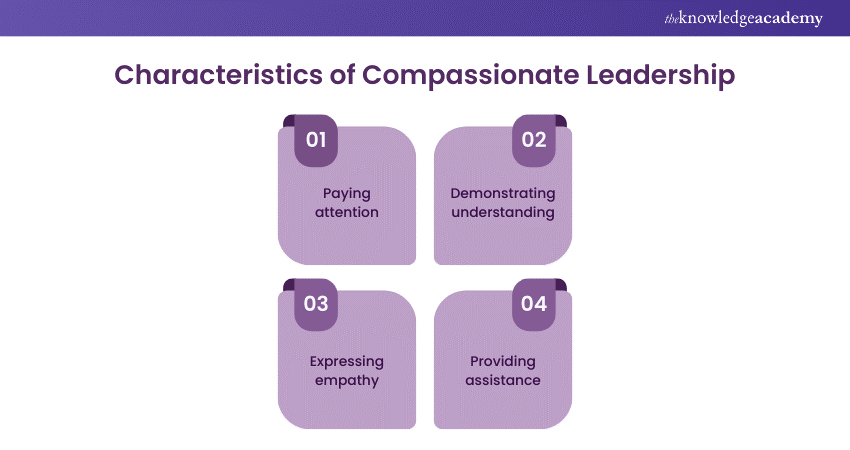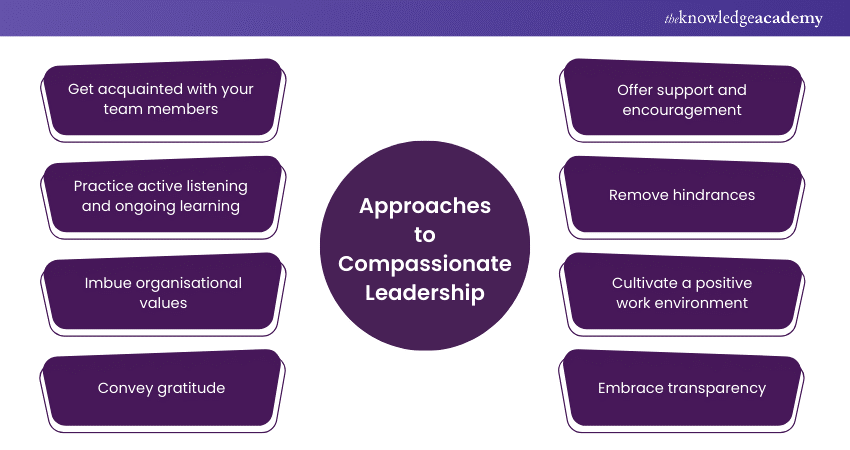We may not have the course you’re looking for. If you enquire or give us a call on 44 1344 203 999 and speak to our training experts, we may still be able to help with your training requirements.
Training Outcomes Within Your Budget!
We ensure quality, budget-alignment, and timely delivery by our expert instructors.

Wondering, “What is Compassionate Leadership?” Compassionate Leadership is a style of Leadership that focuses on the well-being, growth, and success of the people you lead. It is not about being soft or weak but about being strong and caring.
Compassionate Leadership is based on the premise that people perform better when they feel valued, respected, and supported by their Leaders. Compassionate Leadership also benefits Leaders, as it can enhance their emotional intelligence, resilience, and satisfaction.
In this blog, we will explore “What is Compassionate Leadership?” in more detail. We will also look at the characteristics and approaches of Compassionate Leadership that can help you develop and apply this skill.
Table of Contents
1) What is Compassionate Leadership?
2) Four characteristics of Compassionate Leadership
a) Paying attention
b) Demonstrating understanding
c) Expressing empathy
d) Providing assistance
3) Eight approaches to Compassionate Leadership
4) Conclusion
What is Compassionate Leadership?
Compassionate Leadership is a style of Leadership that involves:
a) Recognising the emotions, needs, and challenges of the people you lead
b) Responding to them with kindness, empathy, and support
c) Helping them overcome difficulties and achieve their goals
d) Creating a culture of trust, collaboration, and mutual respect
Compassionate Leadership is not only about being nice or friendly but about being genuinely concerned and committed to the well-being and success of your team members. Compassionate Leadership is not about avoiding conflicts or criticisms but addressing them constructively and respectfully.
Compassionate Leadership is based on the idea that people are not just resources or assets but human beings with feelings, aspirations, and potential. Compassionate Leadership acknowledges that people are imperfect and may face personal or professional challenges affecting their performance and motivation. Compassionate Leadership aims to create a positive and supportive work environment where people can thrive and grow.
Four characteristics of Compassionate Leadership
Compassionate Leadership comprises the following 4 characteristics:

1) Paying attention
Paying attention is the first and foundational characteristic of Compassionate Leadership. It means being mindful and attentive to the people you lead and noticing their emotions, needs, and challenges.
Paying attention is important because it shows that you care about your team members and respect and appreciate their diversity and uniqueness. Paying attention also enables you to identify and address any issues or problems that may arise before they escalate or affect the team’s performance or morale.
Some ways to pay attention as a Compassionate Leader are:
a) Make eye contact and use active listening when talking to your team members.
b) Ask open-ended questions and encourage feedback and input from your team members.
c) Observe your team members' body language, tone of voice, and facial expressions, and check for any signs of stress, discomfort, or dissatisfaction.
d) Schedule regular one-on-one meetings and check-ins with your team members.
e) Show interest and involvement in your team members’ lives outside work, and celebrate their achievements and milestones.
2) Demonstrating understanding
Demonstrating understanding means acknowledging and validating your team members' emotions, needs, and challenges and showing that you appreciate and respect their points of view. Demonstrating understanding also means being flexible and adaptable and adjusting your expectations and actions according to the situation and the person.
Demonstrating understanding is important because it builds trust and rapport between you and your team members and makes them feel heard and valued. It also helps reduce any misunderstandings, conflicts, or tensions that may arise and fosters a culture of openness and honesty.
Some ways to demonstrate understanding as a Compassionate Leader are:
a) Use empathetic statements and expressions, such as “I understand how you feel”, “I appreciate your perspective”, or “I can see why you are frustrated”.
b) Avoid judging, criticising, or dismissing your team members' emotions, needs, or challenges.
c) Express appreciation and recognition for the efforts and contributions of your team members and acknowledge their strengths and achievements.
d) Be flexible and accommodating to your team members' work styles, preferences, and needs.
e) Apologise, take responsibility when you make a mistake, and seek to learn from it and improve.
Start your journey towards effective Leadership with our Successful People Management and Team Leadership Course. Sign up now!
3) Expressing empathy
Expressing empathy is the third characteristic of Compassionate Leadership. It means sharing and connecting with your team members' emotions, needs, and challenges and showing that you care and support them. Expressing empathy also means being kind and compassionate and offering comfort and consolation when needed.
Expressing empathy is important because it creates a bond and a sense of belonging between you and your team members and makes them feel safe and comfortable with you. Expressing empathy inspires your team members to be more empathetic and compassionate towards each other and create a positive and supportive team culture.
Some ways to express empathy as a Compassionate Leader are:
a) Use emotional and supportive language, such as “I’m sorry to hear that”, “I’m here for you”, or “I’m proud of you”.
b) Show genuine concern and interest for the well-being and happiness of your team members and ask them how they are feeling and coping.
c) Help your team members when they are struggling or facing difficulties and connect them with the appropriate resources or support systems.
d) Express positive and uplifting emotions, such as joy, gratitude, or optimism, and share them with your team members.
e) Give hugs, smiles, or other gestures of affection and warmth to your team members when appropriate and comfortable.
4) Providing assistance
Assisting is the fourth and final characteristic of Compassionate Leadership. It means taking action and doing something to help your team members with their emotions, needs, and challenges and to improve their situation and outcome.
Assisting is important because it shows that you know and understand your team members and are willing and able to help them. Assisting also demonstrates your competence and credibility as a Leader and enhances your team members’ trust and respect for you.
Some ways to provide assistance as a compassionate Leader are:
a) Use action-oriented and constructive language, such as “Let me help you with that”, “What can I do for you?” or “How can we make this better?”.
b) Identify and prioritise your team members' most urgent and important needs and challenges and allocate your time and resources accordingly.
c) Provide guidance, coaching, mentoring, or feedback to your team members, and help them develop their skills.
d) Delegate tasks and responsibilities to your team members and empower them to make decisions.
e) Recognise and reward your team members for their achievements and results and give them incentives and opportunities for growth.
Transform your Leadership approach and drive success in Agile environments with our Agile Leadership Training. Join today!
Eight approaches to Compassionate Leadership
Practising Compassionate Leadership involves a range of practical approaches and strategies that Leaders can implement to create a positive and supportive environment for their team members. While these approaches are not exhaustive, they are foundational steps towards fostering empathy, understanding, and collaboration within teams. Let's explore each approach in more detail:

1) Get acquainted with your team members
One of the fundamental steps in practising Compassionate Leadership is to develop a deeper understanding of team members' backgrounds, personalities, and aspirations. Leaders can achieve this by initiating personal interactions, such as introductions and team-building activities, where team members can share information about themselves. Leaders can establish stronger connections with their team members by fostering an environment of openness and trust. Moreover, it also lays the groundwork for effective communication and collaboration.
2) Practice active listening and ongoing learning
Effective communication is essential for Compassionate Leadership, and active listening is crucial in understanding team members' perspectives and concerns. Here’s how Leaders can demonstrate active listening:
1) Using verbal and non-verbal cues to show attentiveness
2) Summarising and repeating key points
3) Asking open-ended questions to encourage dialogue
Additionally, Leaders should embrace a mindset of continuous learning, continually seeking insights and feedback from team members to improve their Leadership approach.
3) Imbue organisational values
Compassionate Leaders align their actions with their organisation's core values and vision, fostering a sense of purpose and belonging among team members. By communicating and reinforcing organisational values through storytelling, recognition, and shared experiences, Leaders can inspire their teams to embrace these principles in their daily work. Creating a culture of integrity, excellence, and innovation empowers team members to contribute meaningfully to the organisation's mission while upholding its ethical standards.
4) Convey gratitude
Expressing gratitude is a powerful way for Leaders to acknowledge and appreciate the efforts of their team members, fostering a culture of recognition and appreciation. By offering genuine praise and recognition for individual and collective achievements, Leaders reinforce positive behaviours and boost morale within the team. Regular expressions of gratitude create a supportive environment where team members feel valued and motivated to perform at their best.
Enhance your Leadership skills and become a more effective Leader with our specialised Leadership Skills Course. Register Now!
5) Offer support and encouragement
Compassionate Leaders prioritise the well-being and development of their team members, providing them with the support and encouragement they need to succeed. Whether offering guidance, resources, or emotional support during challenging times, Leaders demonstrate their commitment to their team's growth and success. Leaders foster a culture of resilience and empowerment within the organisation by empowering team members to overcome obstacles and pursue their goals.
6) Remove hindrances
Influential Leaders identify and address obstacles that impede their team's progress, creating an environment where team members can thrive and excel. Whether addressing workflow inefficiencies, resolving conflicts, or providing additional resources, Leaders take proactive steps to remove barriers to success. Leaders empower their teams to overcome challenges and achieve their objectives by promoting a culture of problem-solving and innovation.
7) Cultivate a positive work environment
Creating a positive and inclusive work environment promotes collaboration, creativity, and employee satisfaction. Compassionate Leaders foster a culture of respect, trust, and camaraderie, where team members feel valued and supported. By promoting open communication, celebrating diversity, and encouraging teamwork, Leaders create a sense of belonging and purpose that motivates team members to perform at their best.
8) Embrace transparency
Transparency is critical to building trust and credibility within teams, as it promotes honesty, accountability, and open communication. Compassionate Leaders prioritise transparency by sharing relevant information, addressing concerns openly, and soliciting feedback from team members. By fostering a culture of transparency and accountability, Leaders create an environment where trust thrives, enabling teams to collaborate effectively and achieve shared goals.
Unlock your Leadership potential and elevate your career with our comprehensive Leadership Courses.
Conclusion
Compassionate Leadership is a journey, not a destination. Compassionate Leadership is a choice, not a requirement. Compassionate Leadership is a gift, not a burden. Compassionate Leadership is a way of being, not a way of doing. We hope this blog has helped you understand “What is Compassionate Leadership?”, why it matters and how to practice it in your organisation. Thank you for reading, and we wish you all the best in your Compassionate Leadership journey.
Equip yourself with the tools and strategies needed to make informed and effective decisions in any situation with our Decision Making Skills Training.
Frequently Asked Questions

Compassionate Leadership differs from traditional styles by emphasising empathy, understanding, and support for team members. Unlike traditional approaches focused solely on results and hierarchy, Compassionate Leadership prioritises the well-being and growth of individuals, fostering a more inclusive and nurturing work environment.

Yes, anyone can learn and apply Compassionate Leadership principles regardless of their role or industry. Compassionate Leadership transcends job titles and sectors, focusing on human connection, empathy, and understanding, making it applicable and beneficial in diverse organisational contexts.

The Knowledge Academy takes global learning to new heights, offering over 30,000 online courses across 490+ locations in 220 countries. This expansive reach ensures accessibility and convenience for learners worldwide.
Alongside our diverse Online Course Catalogue, encompassing 17 major categories, we go the extra mile by providing a plethora of free educational Online Resources like News updates, Blogs, videos, webinars, and interview questions. Tailoring learning experiences further, professionals can maximise value with customisable Course Bundles of TKA.

The Knowledge Academy’s Knowledge Pass, a prepaid voucher, adds another layer of flexibility, allowing course bookings over a 12-month period. Join us on a journey where education knows no bounds.

The Knowledge Academy offers various Leadership Courses, including Leadership Skills and Agile Leadership Trainings. These courses cater to different skill levels, providing comprehensive insights into Organisational Leadership.
Our Business Skills blogs cover a range of topics related to Leadership skills and upskilling, offering valuable resources, best practices, and industry insights. Whether you are a beginner or looking to advance your Leadership skills, The Knowledge Academy's diverse courses and informative blogs have you covered.
Upcoming Business Skills Resources Batches & Dates
Date
 Leadership Skills Training
Leadership Skills Training
Fri 17th Jan 2025
Fri 7th Mar 2025
Fri 23rd May 2025
Fri 18th Jul 2025
Fri 12th Sep 2025
Fri 14th Nov 2025
Fri 12th Dec 2025







 Top Rated Course
Top Rated Course



 If you wish to make any changes to your course, please
If you wish to make any changes to your course, please


